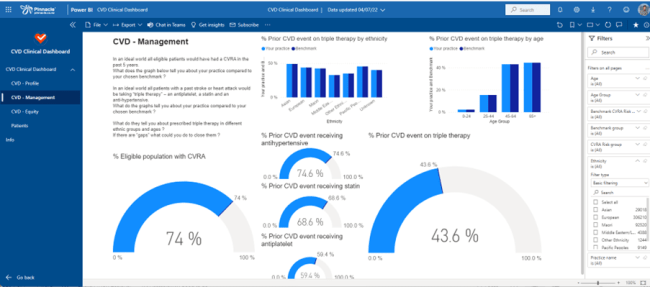
CVD triple therapy needs a boost
Approximately 3-4 per cent of New Zealanders have had a cardiovascular event. Clinical dashboards allow you to look at your practice outcomes and identify patients who may benefit from a review.
Approximately 3-4 per cent of all New Zealanders have had a cardiovascular event.1
Due to the high risk of a repeat event within five years, intensive secondary CVD prevention is recommended.2,3
Secondary prevention aims to reduce the probability of recurrent events in patients with known CVD (e.g. coronary artery disease, cerebrovascular disease, peripheral vascular disease, heart failure)2. It includes using an antithrombotic and medicines to lower lipids and blood pressure (triple therapy), alongside cardiac rehabilitation with education and lifestyle and behavioural strategies.2
Looking at the whole of network figures, similar to the national figures, 43 per cent of people who benefit from triple therapy are receiving it. And interestingly, there isn’t a big gap between our European and our Māori patients.
Your clinical dashboards allow you to look at your individual practice outcomes and to identify patients who may benefit from a review. We know it’s more than busy enough at the moment, this is just a reminder about this important issue for our patients and something to consider at routine medication reviews.
Ask yourself – has this person had a past stroke or myocardial infarction/MI? If so, are they taking triple therapy? If not, why not?
It isn’t appropriate for everyone of course, but probably more than 43 per cent of eligible patients could be benefitting.
We are working on expanding the CVD dashboard, ideas so far have included looking at heart failure medication uptake, and atrial fibrillation management along with lipid and blood pressure control.
If you or your team have ideas about how we can improve the dashboards, any new dashboards you’d like to see (we have respiratory, cancer, and a whānau care and equity dashboard in the pipeline) please get in touch.

- Data from Ministry of Health national collections (2022) provided by Matui, June 2022.
- Perel P, Avezum A, Huffman M, et al. Reducing premature cardiovascular morbidity and mortality in people with atherosclerotic vascular disease. The World Heart Federation roadmap for secondary prevention of cardiovascular disease. Global Heart 2015;10:99–110.
- Ministry of Health. 2018. Cardiovascular Disease Risk Assessment and Management for Primary Care. Wellington: Ministry of Health.
Contact
Jo Scott-Jones, Clinical Director
drjo@pinnacle.health.nz
027 475 0488
Pinnacle has developed a rural chest pain assessment method that allows low-risk patients in rural communities to be safely assessed and managed by their general practice, rather than travelling significant distances to hospital - often needlessly.
Read moreTreatment of patients with suspected ACC related DVT with a Wells Score of >= 2 or a positive D-dimer.
View detailsA range of guides to assist when using the iron infusion programme.